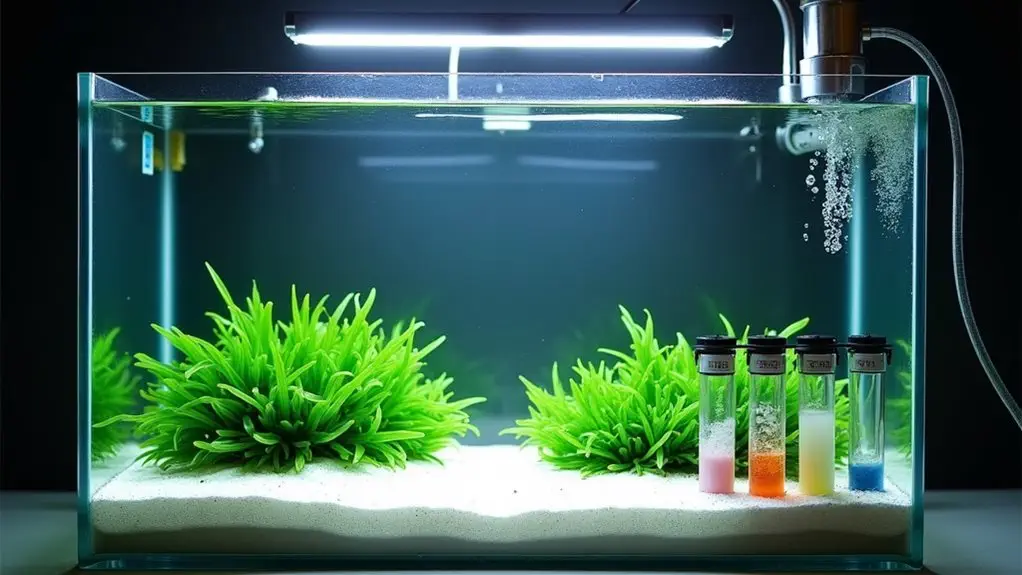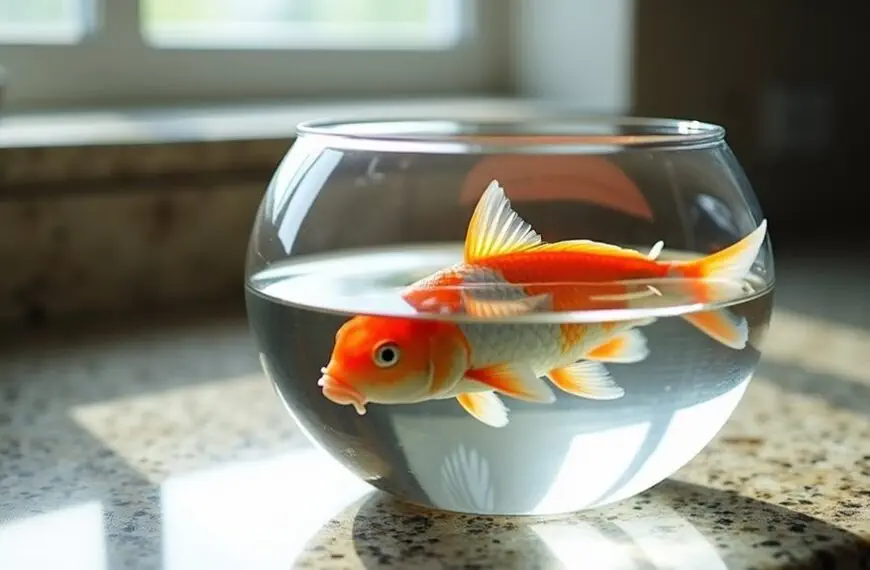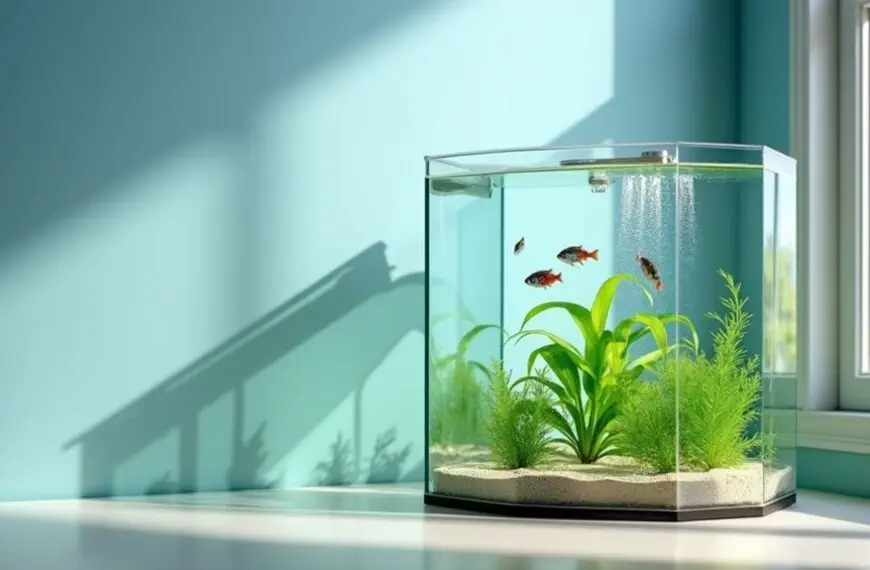You'll want to wait 4-8 weeks after setting up your new aquarium before adding any fish. During this time, your tank needs to complete the nitrogen cycle, which establishes beneficial bacteria that break down harmful waste products. Test your water daily using a reliable test kit, and only add fish when ammonia and nitrite levels read zero, with some nitrates present. Keep the temperature between 78-82°F to promote bacterial growth, and don't rush the process – your future fish will thank you! There's a bit more to successful fish-keeping than just filling a tank with water and dropping in some finned friends.
Contents
- 1 Understanding Tank Cycling
- 2 Essential Water Parameters
- 3 First Fish Selection
- 4 Signs of Tank Readiness
- 5 Proper Acclimation Methods
- 6 Fish Compatibility Guidelines
- 7 Monitoring Water Quality
- 8 Managing Fish Population Growth
- 9 Common Mistakes to Avoid
- 10 Tank Maintenance Schedule
- 11 Frequently Asked Questions
- 11.1 Can I Speed up the Cycling Process Using Water From an Established Tank?
- 11.2 How Long Should I Quarantine New Fish Before Adding Them?
- 11.3 Should I Feed Fish on Their First Day in the New Tank?
- 11.4 What Happens if My Filter Stops Working During the Cycling Period?
- 11.5 Is It Necessary to Remove Decorations When Adding New Fish?
- 12 Final Thoughts
Understanding Tank Cycling
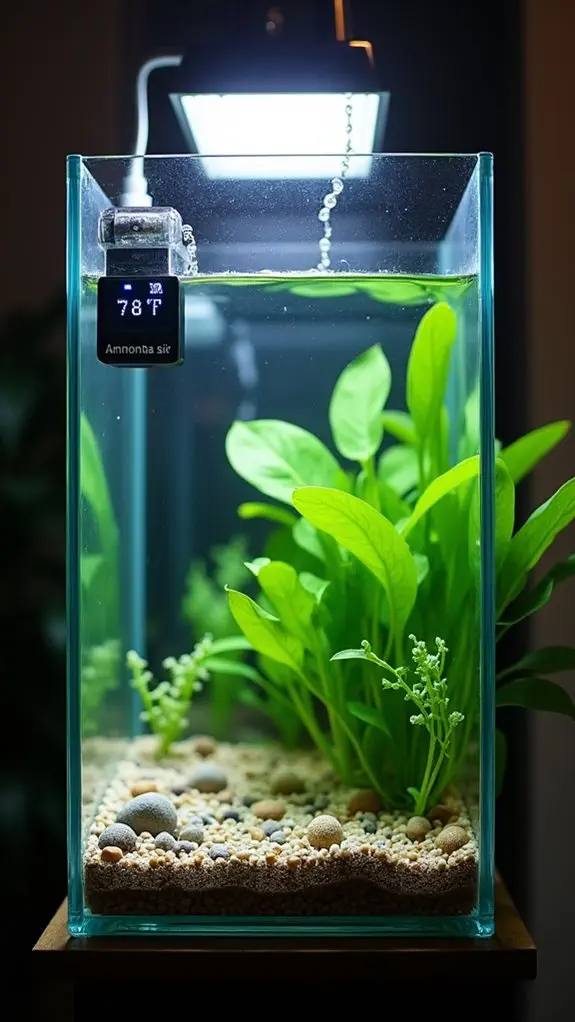
A healthy fish tank relies on an essential process called tank cycling. Think of it as creating a miniature ecosystem where beneficial bacterial colonies work tirelessly to keep your fish safe from harmful toxins. During this process, you'll need to be patient as your tank develops its natural filtration system. Adding too many fish too soon can lead to New Tank Syndrome. Waiting 24 to 48 hours after initial setup allows for stable water conditions.
When you're setting up your new tank, you'll start by filling it with dechlorinated water and getting your filter running. The cycling duration typically ranges from 4 to 8 weeks, during which amazing chemical transformations occur. This process is crucial as it establishes the nitrogen cycle, ensuring your fish thrive in a balanced environment.
You'll need to add small amounts of ammonia daily, which kickstarts the growth of special bacteria that convert toxic substances into safer compounds.
You'll want to monitor your tank's progress by testing the water every couple of days. The ideal conditions for cycling include maintaining a pH between 7.0 and 7.8 and keeping the temperature between 83°F and 87°F.
Think of yourself as a scientist during this time – you're watching levels of ammonia, nitrite, and nitrate change as your tank matures. When ammonia and nitrite reach zero, and nitrate is present, you've successfully cycled your tank!
Essential Water Parameters
Water parameters serve as vital signs for your aquarium's health, much like pulse and temperature readings for humans.
You'll need to monitor several key factors to guarantee your fish thrive in their new home. Water temperature should stay consistent within specific ranges – 72-82°F for freshwater and 76-83°F for saltwater tanks. Stable temperatures are especially important for coral health in reef tanks. Regular testing is essential to accurately track these crucial parameters consistently.
Don't forget to check pH levels regularly, as they're essential for your fish's well-being. Keeping track of ammonia toxicity is non-negotiable – you'll want to maintain zero ammonia in freshwater and less than 0.02 ppm in saltwater tanks.
Your nitrate balance should stay between 1-10 ppm, while hardness levels vary based on your setup. If you're planning a planted tank, you'll need to pay extra attention to phosphate levels and alkalinity importance, keeping them at 0.5 ppm and 4-8 dKH respectively.
First Fish Selection

Choosing your first fish is a critical decision that shapes your aquarium's future success. When you're ready to start stocking your tank, you'll want to focus on fish selection criteria that guarantee a peaceful community. Goldfish and cyprinids make excellent starter choices due to their sociable nature and ease of breeding. UV sterilization can help protect your initial fish selection from potential disease outbreaks.
Start with hardy, passive fish that can handle the occasional water parameter fluctuation, and always research compatible species before making your purchase. Additionally, opting for schooling species like tetras can enhance the sociability of your aquarium setup.
Here's why selecting the right first fish matters:
- They'll set the tone for your tank's ecosystem, creating a foundation for future additions.
- Your initial choices can mean the difference between a thriving community and constant chaos.
- Success with your first fish will boost your confidence as an aquarist.
Signs of Tank Readiness
Before you add your first fish, you'll want to check that your tank's water parameters are consistently stable, with no signs of ammonia or nitrites.
You can confirm this by testing your water daily for at least a week, making sure the readings stay at zero for both chemicals while seeing some nitrates present.
These stable readings, along with the presence of nitrates, tell you that your tank's nitrogen cycle is complete and your beneficial bacteria are ready to handle the waste from your new fish friends. Additionally, it is important to maintain the cycling temperature of 78F to 82F to foster maximum bacteria growth throughout the process.
The entire process typically takes 4-6 weeks for your aquarium to properly establish the beneficial bacterial colonies needed for a safe environment.
Using a water test kit regularly is essential for monitoring these parameters accurately and ensuring your tank is truly ready for fish.
Water Test Parameters Stable
Keeping track of your water parameters is essential for determining tank readiness. You'll need to monitor several key factors to guarantee your aquarium is safe for its future inhabitants. Testing frequently helps you understand pH fluctuations and hardness levels, which directly impact your fish's well-being. Strip tests or drop tests provide reliable measurement options for regular monitoring. A proper quarantine setup will help maintain stable parameters when introducing new fish.
When your water quality remains stable for at least two weeks, you're on the right track of your cycling timeline. It's also beneficial to ensure that your beneficial bacteria colonies are well-established, as they play a critical role in reducing ammonia and nitrite levels.
Here's what stable parameters feel like emotionally:
- The joy of seeing ammonia and nitrite readings at zero – it's like acing an important test!
- The satisfaction of consistent pH readings – like finding the perfect rhythm in your favorite song.
- The relief of proper nitrate management – similar to keeping your home perfectly clean.
Your testing routine should include regular checks for ammonia toxicity, nitrite spikes, and temperature stability. Don't forget about phosphate monitoring, especially if you're planning to add live plants. Remember, it's better to be patient and wait for stable readings than to rush and risk your fish's health.
When all parameters remain steady for two consecutive weeks, you'll know your tank is truly ready for its new residents.
Nitrogen Cycle Complete
Before adding any fish, make sure your tank has maintained these stable readings for at least a week. Your API Master Test Kit will be your best friend during this time, helping you monitor all the important parameters. Regular testing will help prevent toxic buildup, ensuring a safe environment for your new fish.
Proper Acclimation Methods
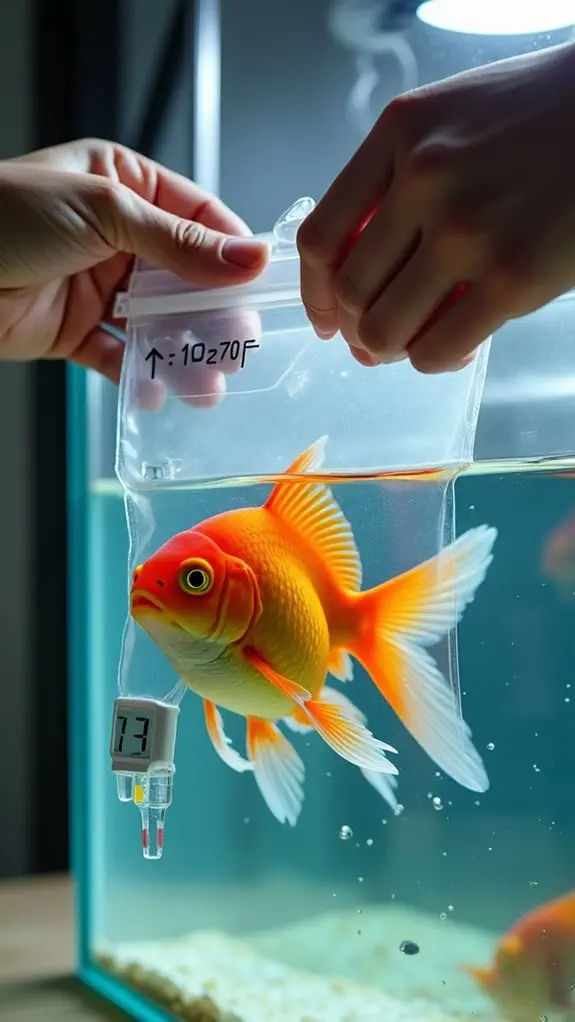
A fish's successful change to a new aquarium depends heavily on proper acclimation. You'll want to focus on gradual acclimation timing to minimize fish stress and help your new pets adapt to their environment.
There are two reliable methods you can use: the floating method and the drip method, with the latter being ideal for more sensitive species.
When you're ready to introduce your fish, here's why proper acclimation matters:
- Your fish will thank you by showing vibrant colors and active behavior instead of hiding in corners.
- You'll avoid the heartbreak of losing fish to preventable shock or stress.
- Your aquarium community will remain peaceful and harmonious with healthy newcomers.
Start by floating the sealed bag in your tank for about 15-30 minutes to match temperatures.
Then, whether you're using the floating or drip method, you'll want to gradually add tank water to the bag. This helps your fish adjust to the new water chemistry without shock.
Don't rush this process – taking your time now means you'll have happy, healthy fish later. Additionally, ensuring that the tank conditions like temperature and pH are suitable for your chosen species is crucial during this transition.
Remember to dim the lights during acclimation, and always use a net when transferring fish to avoid introducing bag water to your tank.
Fish Compatibility Guidelines
Successful fish communities depend on carefully matching compatible species. When you're planning your aquarium, you'll need to take into account several key factors that influence fish behavior and species compatibility. Think of it like creating a tiny underwater neighborhood – you wouldn't want to put a shark next to a guppy!
Before adding new fish to your tank, research their size, temperament, and dietary needs. You'll want to avoid mixing large fish with smaller ones that could become an unexpected snack.
Water parameters are essential too – different species require specific pH levels, temperatures, and salinity ranges to thrive. For example, while guppies get along swimmingly with neon tetras and corydoras, they mightn't fare well with more aggressive species like African cichlids.
Don't forget to take into account territory requirements – some fish need more personal space than others. If you're planning to keep territorial species, make sure your tank is large enough to prevent fin-nipping disputes.
It's like having roommates – some fish are social butterflies, while others prefer their own corner of the tank. Remember, even with careful planning, individual fish personalities can vary, so monitor your aquatic community closely. Moreover, understanding community dynamics enhances the chances of maintaining a peaceful coexistence among different fish types.
Monitoring Water Quality
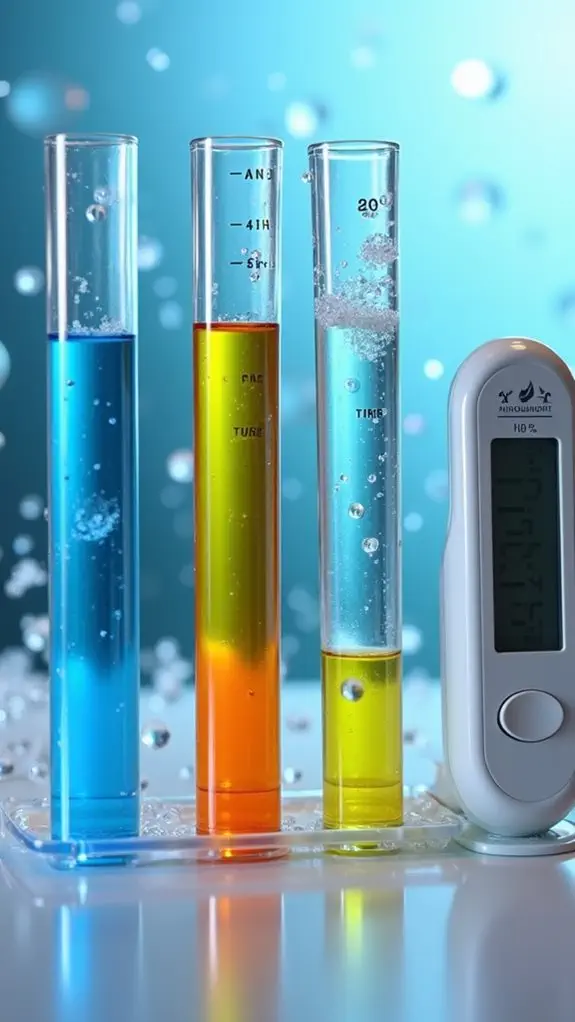
Before you add any fish to your new tank, you'll need to monitor several key water parameters, including ammonia, nitrite, nitrate, pH, and temperature.
You can easily track these measurements using test strips or liquid test kits, which should become part of your daily routine during the cycling process.
These daily checks aren't just busy work – they'll tell you exactly when your tank is safe and ready for its first fishy residents. Consistently maintaining optimal ammonia levels will significantly reduce the risk of fish stress or death, ensuring a healthier environment.
Essential Testing Parameters
Water testing serves as the foundation of a healthy aquarium environment. You'll need to monitor several key parameters with the right testing frequency to guarantee your fish stay healthy and happy. Testing for pH, ammonia, nitrite, and nitrate will give you vital insights into your tank's parameter impact, helping you make informed decisions about when it's safe to add fish.
- You'll feel more confident knowing your fish aren't swimming in toxic water when you test ammonia and nitrite levels (they should always be at zero!)
- You'll experience peace of mind watching your fish thrive in properly balanced water chemistry.
- You'll avoid the heartbreak of losing fish to poor water conditions by staying on top of your testing routine.
Your testing kit will become your aquarium's best friend – think of it as a doctor's stethoscope for your tank! Additionally, maintaining optimal pH levels is essential for preventing stress and health complications in your tropical fish.
Make sure you're using fresh, unexpired test kits and following the instructions carefully. Whether you choose liquid test kits or strips, you'll want to maintain a regular testing schedule.
Daily Measurement Schedule
Consistency in monitoring your aquarium's water quality forms the backbone of successful fishkeeping.
Daily testing becomes especially important during the first few weeks of setting up your new tank, as this period can make or break your aquarium's success.
You'll want to establish a measurement schedule that works with your routine. During the initial setup phase, test your water parameters every couple of days using an API Master Test Kit.
Pay close attention to ammonia and nitrite levels, as these can spike unexpectedly in new tanks. Don't skip any measurements – it's better to test too often than not enough!
Once your tank stabilizes, you can reduce testing to every 1-2 months if everything's running smoothly.
However, if you notice any concerning signs like sick fish or excessive algae growth, increase your testing frequency immediately.
Think of it like taking your pet's temperature when they're not feeling well – it's an essential diagnostic tool.
Managing Fish Population Growth
Fish populations follow a predictable pattern called the logistic growth model, which starts with exponential growth before leveling off at the ecosystem's carrying capacity.
When you're managing your tank, you'll need to understand these population dynamics to keep your aquatic friends happy and healthy. Just like a bustling city, your tank has limits on how many fish it can comfortably support.
To maintain a thriving aquarium community, you'll want to implement smart harvesting strategies and regular monitoring.
Think of yourself as the mayor of this underwater city, making sure everyone has enough space and resources to flourish.
Here are three exciting ways your fish population will surprise you:
- They'll multiply faster than your weekend Netflix binges if conditions are right
- They'll create their own social hierarchy, complete with fish "neighborhoods"
- They'll show you when the tank is getting crowded through their behavior changes
Common Mistakes to Avoid
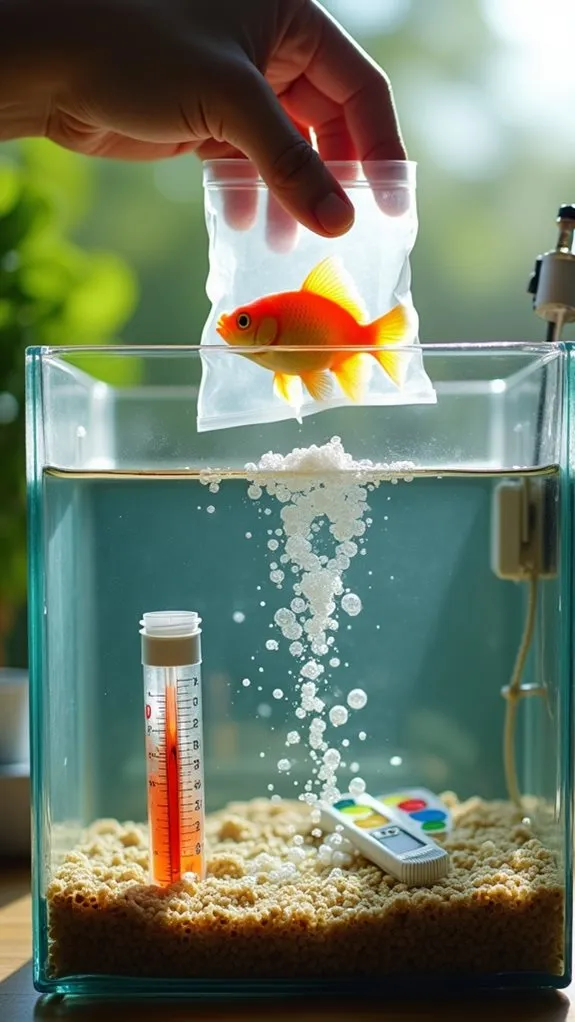
As an enthusiastic new aquarium owner, you'll want to add fish right away, but rushing the cycling process is one of the biggest mistakes you can make.
You'll also need to resist the temptation to add too many fish at once, as overstocking can quickly overwhelm your tank's biological filtration system.
Before adding any new fish, it's vital to perform water tests for ammonia, nitrite, and nitrate levels, as skipping these essential checks can lead to stressed, unhealthy fish in your new aquatic home.
Rushing The Cycling Process
Many aquarists make the critical mistake of rushing their tank's cycling process, leading to devastating consequences for their fish and overall aquarium health.
The temptation to add fish quickly is understandable, but you'll want to avoid common cycling mistakes like using fish-in methods or relying on questionable bottled bacteria products.
Instead of rushing, consider these proven cycling alternatives: fishless cycling with ammonia, using established filter media, or trying the milk jug sponge filter method.
These approaches will help you build a strong foundation of beneficial bacteria without putting any fish at risk.
Here's why rushing the cycle will break your heart:
- You'll watch your beloved fish struggle with ammonia poisoning, gasping at the surface as they fight to survive.
- Your dream aquarium will turn into a cloudy, unhealthy mess that's frustrating to fix.
- You'll end up spending more time and money treating diseases that could have been prevented.
Overstocking Too Quickly
Frequently, novice aquarists fall into the trap of adding too many fish too quickly, overwhelming their tank's biological filtration system. When you introduce too many fish at once, you'll notice serious overstocking consequences that can harm your aquatic friends and destabilize your tank's ecosystem.
You'll spot fish stress indicators when your tank is overcrowded – your fish might appear lethargic, gasp at the surface, or display aggressive behavior as they compete for space. It's like trying to fit twenty people in a tiny elevator – nobody's happy!
Your water quality will also take a hit, with ammonia and nitrate levels rising faster than a frightened fish darting away from a net.
To avoid these issues, remember the golden rule: add fish slowly and in small numbers. Think of it as a gradual house-warming party for your tank!
Monitor your water parameters regularly, and don't let those puppy-dog eyes at the fish store tempt you into bringing home more fish than your tank can handle. If you notice signs of overcrowding, consider upgrading to a larger tank or rehoming some fish to maintain a healthy, balanced aquarium.
Skipping Water Tests
Beyond avoiding overstocking, one of the biggest mistakes new aquarists make is skipping their water tests. The water test significance can't be overstated – it's like having a health checkup for your aquarium.
Without regular testing, you won't know if your fish are swimming in safe conditions or toxic soup. Think of testing frequency as your aquarium's essential signs monitoring system; you'll need to test daily during cycling, then weekly as your tank stabilizes.
Here's what can go wrong when you skip water tests:
- Your fish might suffer silently as ammonia levels creep up, leading to stress and illness that could've been prevented with a simple test.
- You'll miss early warning signs of water quality issues, turning minor problems into major disasters.
- The money you've invested in fish and equipment could literally go down the drain when preventable problems spiral out of control.
Tank Maintenance Schedule
A well-structured maintenance schedule is vital for keeping your aquarium healthy before and after adding fish.
You'll need to perform specific tasks daily, weekly, bi-weekly, and monthly to guarantee your tank remains in prime condition. Think of it as creating a cozy home that'll keep your future fish friends happy and thriving.
Your daily routine should include checking equipment, monitoring fish behavior, and removing excess food – it's like tidying up your living room every day!
Weekly tasks focus on more detailed tank cleaning and equipment maintenance, including gravel vacuuming and filter inspections. Don't skip these, as they're essential for preventing problems before they start.
Every two weeks, you'll want to change 10-15% of the water and give those aquarium walls a good scrub. It's like giving your tank a mini spa day!
Monthly maintenance is your chance to do a thorough deep-clean and check everything from equipment to plant growth.
Frequently Asked Questions
Can I Speed up the Cycling Process Using Water From an Established Tank?
Yes, you'll speed up cycling benefits by adding established tank water. It introduces beneficial bacteria and improves water quality. Transfer both water and filter media, but don't clean them before moving to maximize results.
How Long Should I Quarantine New Fish Before Adding Them?
You'll need to quarantine new fish for 4-6 weeks for ideal stress reduction and health monitoring. Don't rush this process – it's crucial to protect your existing fish from potential diseases or parasites.
Should I Feed Fish on Their First Day in the New Tank?
Don't feed fish on their first day in the tank. You'll want to give them 24 hours for proper acclimation. They're typically too stressed to eat immediately, and waiting helps them adjust better.
What Happens if My Filter Stops Working During the Cycling Period?
If your filter stops working, you'll disrupt the cycling process and lose beneficial bacteria. You'll need to fix it quickly and maintain proper filter maintenance to resume cycling. Don't neglect regular cycling tips.
Is It Necessary to Remove Decorations When Adding New Fish?
You don't need to remove decorations when adding new fish. Keeping the existing tank layout helps reduce stress and provides hiding spots. Just guarantee there's enough space for fish compatibility and territory needs.
Final Thoughts
You're now equipped to add fish to your new tank with confidence! Remember to be patient with cycling, maintain proper water parameters, and choose your first fish wisely. By following the right acclimation steps and keeping a close eye on water quality, you'll create a thriving aquatic home. Don't rush the process – your fish will thank you with years of swimming joy and vibrant health in their well-prepared habitat.

